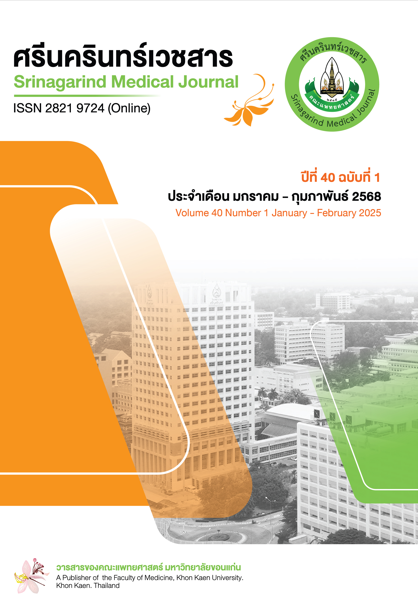Lipidomic Profiles of Cancer-Associated Fibroblasts with Cholangiocarcinoma Patients
Keywords:
cancer-associated fibroblasts, cholangiocarcinoma, lipidomicsAbstract
Background and Objectives: Lipids is an essential component in tumor and they facilitate tumor growth and metastasis. Cancer-associated fibroblasts (CAFs) are defined as a tumor environment (TME) by which cells reside in stromal compartments supporting tumor progression. The lipid profile of CAFs, particularly in cholangiocarcinoma (CCA), have been unexploited. We aimed to investigate lipid profiles in CAFs of patients with CCA using lipidomic approach.
Methods: Three samples of CAFs were primarily isolated from tumor tissues of patients with CCA and subcultured in the laboratory. Lipid profiles in CAFs compared with normal fibroblasts (NFs) were analyzed by a non-targeted lipidomic analysis platform using ultra-high performance liquid chromatography-tandem mass spectroscopy (UHPLC-MS/MS).
Results: Forty-three lipid species in 3 groups were determined in CAFs including phosphatidylethanolamines, sphingomyelins and phosphatidylcholines. Those lipids presented in different levels between CAFs and NFs.
Conclusion: Lipids in CAFs are associated with metabolic adaptation that might support tumor progression and metastasis in CCA. The lipid profiles in these CAFs have the potential to be applied in targeted therapies that disrupt metabolic interactions between CAFs and CCA cells.
References
Sahat O, Kamsa-Ard S, Suwannatrai AT, Lim A, Kamsa-Ard S, Bilheem S, et al. Spatial analysis of cholangiocarcinoma in Thailand from 2012 to 2021; a population-based cancer registries study. PLoS One 2024;19(12):e0311035. doi:10.1371/journal.pone.0311035.
Sripa B, Brindley PJ, Mulvenna J, Laha T, Smout MJ, Mairiang E, et al. The tumorigenic liver fluke Opisthorchis viverrini--multiple pathways to cancer. Trends Parasitol 2012;28(10):395-407. doi: 10.1016/j.pt.2012.07.006.
Zhang XF, Dong M, Pan YH, Chen JN, Huang XQ, Jin Y, et al. Expression pattern of cancer-associated fibroblast and its clinical relevance in intrahepatic cholangiocarcinoma. Hum Pathol 2017;65:92-100. doi:10.1016/j.humpath.2017.04.014.
Comito G, Giannoni E, Segura CP, Barcellos-de-Souza P, Raspollini MR, Baroni G, et al. Cancer-associated fibroblasts and M2-polarized macrophages synergize during prostate carcinoma progression. Oncogene 2014;33(19):2423-31. doi:10.1038/onc.2013.191.
Hwang RF, Moore T, Arumugam T, Ramachandran V, Amos KD, Rivera A, et al. Cancer-associated stromal fibroblasts promote pancreatic tumor progression. Cancer Res 2008;68(3):918-26. doi:10.1158/0008-5472.CAN-07-5714.
Kramer N, Schmollerl J, Unger C, Nivarthi H, Rudisch A, Unterleuthner D, et al. Autocrine WNT2 signaling in fibroblasts promotes colorectal cancer progression. Oncogene 2017;36(39):5460-72. doi:10.1038/onc.2017.144.
Worzfeld T, Pogge von Strandmann E, Huber M, Adhikary T, Wagner U, Reinartz S, et al. The Unique Molecular and Cellular Microenvironment of Ovarian Cancer. Front Oncol 2017;7:24. doi:10.3389/fonc.2017.00024.
Raffaghello L, Vacca A, Pistoia V, Ribatti D. Cancer associated fibroblasts in hematological malignancies. Oncotarget 2015;6(5):2589-603. doi:10.18632/oncotarget.2661.
Morandi A, Giannoni E, Chiarugi P. Nutrient Exploitation within the Tumor-Stroma Metabolic Crosstalk. Trends Cancer 2016;2(12):736-46. doi:10.1016/j.trecan.2016.11.001.
Chiarugi P, Cirri P. Metabolic exchanges within tumor microenvironment. Cancer Lett 2016;380(1):272-80. doi:10.1016/j.canlet.2015.10.027.
Kuzet SE, Gaggioli C. Fibroblast activation in cancer: when seed fertilizes soil. Cell Tissue Res 2016;365(3):607-19. doi:10.1007/s00441-016-2467-x.
Donoso-Quezada J, Ayala-Mar S, Gonzalez-Valdez J. The role of lipids in exosome biology and intercellular communication: Function, analytics and applications. Traffic 2021;22(7):204-20. doi:10.1111/tra.12803.
Zechner R, Zimmermann R, Eichmann TO, Kohlwein SD, Haemmerle G, Lass A, et al. FAT SIGNALS--lipases and lipolysis in lipid metabolism and signaling. Cell Metab 2012;15(3):279-91. doi:10.1016/j.cmet.2011.12.018.
Peng S, Li Y, Huang M, Tang G, Xie Y, Chen D, et al. Metabolomics reveals that CAF-derived lipids promote colorectal cancer peritoneal metastasis by enhancing membrane fluidity. Int J Biol Sci 2022;18(5):1912-32. doi:10.7150/ijbs.68484.
Kittirat Y, Suksawat M, Thongchot S, Padthaisong S, Phetcharaburanin J, Wangwiwatsin A, et al. Interleukin-6-derived cancer-associated fibroblasts activate STAT3 pathway contributing to gemcitabine resistance in cholangiocarcinoma. Front Pharmacol 2022;13:897368. doi:10.3389/fphar.2022.897368.
Kittirat Y, Phetcharaburanin J, Promraksa B, Kulthawatsiri T, Wangwiwatsin A, Klanrit P, et al. Lipidomic Analyses Uncover Apoptotic and Inhibitory Effects of Pyrvinium Pamoate on Cholangiocarcinoma Cells via Mitochondrial Membrane Potential Dysfunction. Front Public Health 2021;9:766455. doi:10.3389/fpubh.2021.766455.
Peng S, Chen D, Cai J, Yuan Z, Huang B, Li Y, et al. Enhancing cancer-associated fibroblast fatty acid catabolism within a metabolically challenging tumor microenvironment drives colon cancer peritoneal metastasis. Mol Oncol 2021;15(5):1391-411. doi:10.1002/1878-0261.12917.
Takanashi Y, Kahyo T, Sekihara K, Kawase A, Setou M, Funai K. Prognostic potential of lipid profiling in cancer patients: a systematic review of mass spectrometry-based studies. Lipids Health Dis 2024;23(1):154. doi:10.1186/s12944-024-02121-0.
Eiriksson FF, Nohr MK, Costa M, Bodvarsdottir SK, Ogmundsdottir HM, Thorsteinsdottir M. Lipidomic study of cell lines reveals differences between breast cancer subtypes. PLoS One 2020;15(4):e0231289. doi:10.1371/journal.pone.0231289.
Sah S, Bifarin OO, Moore SG, Gaul DA, Chung H, Kwon SY, et al. Serum Lipidome Profiling Reveals a Distinct Signature of Ovarian Cancer in Korean Women. Cancer Epidemiol Biomarkers Prev 2024;33(5):681-93. doi:10.1158/1055-9965.EPI-23-1293.
Li RZ, Wang XR, Wang J, Xie C, Wang XX, Pan HD, et al. The key role of sphingolipid metabolism in cancer: New therapeutic targets, diagnostic and prognostic values, and anti-tumor immunotherapy resistance. Front Oncol 2022;12:941643. doi:10.3389/fonc.2022.941643.
Nedaeinia R, Najafgholian S, Salehi R, Goli M, Ranjbar M, Nickho H, et al. The role of cancer-associated fibroblasts and exosomal miRNAs-mediated intercellular communication in the tumor microenvironment and the biology of carcinogenesis: a systematic review. Cell Death Discov 2024;10(1):380. doi:10.1038/s41420-024-02146-5.
Jiang T, Dai L, Li P, Zhao J, Wang X, An L, et al. Lipid metabolism and identification of biomarkers in asthma by lipidomic analysis. Biochim Biophys Acta Mol Cell Biol Lipids 2021;1866(2):158853. doi:10.1016/j.bbalip.2020.158853.
Downloads
Published
How to Cite
Issue
Section
License
Copyright (c) 2025 Srinagarind Medical Journal

This work is licensed under a Creative Commons Attribution-NonCommercial-NoDerivatives 4.0 International License.



